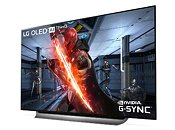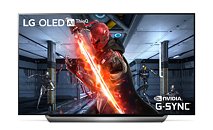Tuesday, September 10th 2019

LG Unveils First OLED TVs with NVIDIA G-SYNC Support
LG Electronics (LG) has joined forces with NVIDIA to make gamers' dreams come true, adding support for NVIDIA G-SYNC Compatibility to its stunning 2019 OLED TVs (model 65/55E9, model 77/65/55C9). LG's newest OLED products offer blazing speed and stunning color reproduction, their superior performance and image quality validated through NVIDIA G-SYNC Compatible testing to ensure a smooth and immersive gaming experience without flickering, tearing or stuttering.
With exceptional picture quality, low input lag and an ultra-fast response time, LG OLED TVs have already earned a reputation for delivering an optimized gaming performance. The addition of NVIDIA G-SYNC Compatibility raises the bar once more, guaranteeing even more immersive big-screen PC gaming on the company's industry-leading 4K OLED models, available in 55- to 77-inch screen sizes.LG's self-emissive OLED technology takes users deeper into the pulsating action of their favorite games, employing the precision of individual pixel control to produce incredibly realistic images. Along with infinite contrast and highly accurate color reproduction, the TVs offer an ultra-fast response time with a refresh rate of up to 120Hz. Input lag - which can make the difference between victory and defeat - is barely perceptible at a 6 milliseconds range for 1440p content at 120 Hz and 13 milliseconds range for 4K content at 60 Hz. The minimal input lag of LG's OLED TVs, of less than a frame, with no loss in picture quality, makes them the best displays for gaming.
What's more, LG's latest OLED TV models support a variety of popular HDR formats that further elevate the gaming experience. Users can play compatible titles in dynamic HDR10 or Dolby Vision (at up to 120 frames per second for Full HD content) taking advantage of HDMI 2.1 specifications such as auto low latency mode (ALLM), enhanced audio return channel (eARC), and variable refresh rate (VRR).
To heighten viewers' sense of immersion when playing games or watching fast content, LG's 2019 OLED TVs support cinematic audio formats including Dolby Atmos and groundbreaking Dolby TrueHD lossless sound technology. With the best premium audio and video format options covered, users can hear and see content as originally intended by its creators. These models also incorporate LG's deep learning-based AI sound for captivating virtual 5.1 surround.
"It's no secret LG OLED TVs are coveted by gamers world over and we are committed to optimizing the OLED gaming experience for them," Sam Kim, senior vice president of the TV product planning division of Home Entertainment company at LG. "With NVIDIA G-SYNC adoption, we are showing that OLED TVs have the support and backing of the world's top gaming hardware brand to make their products look their best."
"We are excited to bring G-SYNC Compatible support to LG's 2019 OLED TVs and HDMI Variable Refresh Rate support to our GeForce RTX 20-Series GPUs," said Matt Wuebbling, head of GeForce marketing at NVIDIA. "Gamers will be blown away by the responsiveness and the lifelike visuals on these TVs when playing the latest PC games featuring real-time ray-tracing powered by GeForce."
NVIDIA G-SYNC Compatible support for LG's 2019 OLED TVs will become available in select markets via a firmware upgrade in the weeks to follow.
With exceptional picture quality, low input lag and an ultra-fast response time, LG OLED TVs have already earned a reputation for delivering an optimized gaming performance. The addition of NVIDIA G-SYNC Compatibility raises the bar once more, guaranteeing even more immersive big-screen PC gaming on the company's industry-leading 4K OLED models, available in 55- to 77-inch screen sizes.LG's self-emissive OLED technology takes users deeper into the pulsating action of their favorite games, employing the precision of individual pixel control to produce incredibly realistic images. Along with infinite contrast and highly accurate color reproduction, the TVs offer an ultra-fast response time with a refresh rate of up to 120Hz. Input lag - which can make the difference between victory and defeat - is barely perceptible at a 6 milliseconds range for 1440p content at 120 Hz and 13 milliseconds range for 4K content at 60 Hz. The minimal input lag of LG's OLED TVs, of less than a frame, with no loss in picture quality, makes them the best displays for gaming.
What's more, LG's latest OLED TV models support a variety of popular HDR formats that further elevate the gaming experience. Users can play compatible titles in dynamic HDR10 or Dolby Vision (at up to 120 frames per second for Full HD content) taking advantage of HDMI 2.1 specifications such as auto low latency mode (ALLM), enhanced audio return channel (eARC), and variable refresh rate (VRR).
To heighten viewers' sense of immersion when playing games or watching fast content, LG's 2019 OLED TVs support cinematic audio formats including Dolby Atmos and groundbreaking Dolby TrueHD lossless sound technology. With the best premium audio and video format options covered, users can hear and see content as originally intended by its creators. These models also incorporate LG's deep learning-based AI sound for captivating virtual 5.1 surround.
"It's no secret LG OLED TVs are coveted by gamers world over and we are committed to optimizing the OLED gaming experience for them," Sam Kim, senior vice president of the TV product planning division of Home Entertainment company at LG. "With NVIDIA G-SYNC adoption, we are showing that OLED TVs have the support and backing of the world's top gaming hardware brand to make their products look their best."
"We are excited to bring G-SYNC Compatible support to LG's 2019 OLED TVs and HDMI Variable Refresh Rate support to our GeForce RTX 20-Series GPUs," said Matt Wuebbling, head of GeForce marketing at NVIDIA. "Gamers will be blown away by the responsiveness and the lifelike visuals on these TVs when playing the latest PC games featuring real-time ray-tracing powered by GeForce."
NVIDIA G-SYNC Compatible support for LG's 2019 OLED TVs will become available in select markets via a firmware upgrade in the weeks to follow.


41 Comments on LG Unveils First OLED TVs with NVIDIA G-SYNC Support
This is just a Freesync/Adaptive sync monitor that Nvidia (finally) made work for their cards.
Its pretty amazing companies are willing to throw such a shroud over this entire thing making it look like Nvidia G-sync was a great idea instead of AMD's approach....
www.techpowerup.com/forums/threads/lg-announces-ultragear-ips-1-ms-lineup-with-nvidia-g-sync.258956/
"G-Sync Compatible" doesn't come up until third paragraph in.
It's not even about FreeSync vs G-Sync, in true the display uses AdaptiveSync, a VESA standard. They should just stick to VESA for branding and mention compatibility with FreeSync/G-Sync in specs. But hey, I guess "NVIDIA G-Sync" drives sales better than AdaptiveSync.
There will be an Nvidia driver released later this year that will detect if your PC is hooked up to an LG OLED and enable it through the HDMI 2.1 connection.
This is actually big news, to me at least. The missing piece of information is whether Nvidia is actually capable of getting 4k@120Hz out of their Turing cards. That would be another quite an accomplishment. They are introducing an HDMI 2.1 feature here, so fingers crossed. But that may be pushing it. If Turing was actually HDMI 2.1 capable, I'm sure they would have had that as a bullet point from launch.
Things really are going towards the right track these days, DP with Adaptive-Sync and HDMI 2.1 with VRR are standard solutions and we can expect both AMD and Nvidia as well as Intel to support these. How the branding will work, does not really matter.
Edit:
By the way, as far as I know, LG-s 9-series OLED TVs do not work with Freesync (yet). Technical details of the implementation are said to be different between HDMI 2.1 VRR and Freesync.
Standardization committees getting their shit together would have to be part of a good solution as well. DP Adaptive Sync and Freesync are plastered over everything even when the feature works like crap. I am afraid HDMI 2.1 VRR will follow the same pattern. GSync Compatible and Freesync 2 will probably have their place to distinguish good implementations.
HDMI 2.1 has VRR, HDMI 2.0 does not.
Freesync over HDMI is based on DP Adaptive-Sync but is a proprietary feature.
See this as a cold run and testing for the upcoming G-Sync compatible invasion by nVidia.
nVidia aims to push down FreeSync as much as possible with a massive G-Sync Compatible push the coming years.
The normal G-Sync module with DP 1.2 and 8-bit color will live on for a while as long as manufacturers want it and then put out to pasture without being replaced with new hardware.
The new normal will then be G-Sync Compatible and for so called medium upper class and high end G-Sync Ultra will be used.
By the way, nVidia is actually working on a custom chip for fan less version of G-Sync Ultra module BUT it is still up to two years away before it appears in products, they want to get away from the expensive and hot Intel's FPGA unit - Altera Arria 10 GX 480